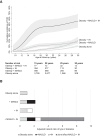Steatotic Liver Disease in Pediatric Obesity and Increased Risk for Youth-Onset Type 2 Diabetes
- PMID: 39373987
- PMCID: PMC11655408
- DOI: 10.2337/dc24-1236
Steatotic Liver Disease in Pediatric Obesity and Increased Risk for Youth-Onset Type 2 Diabetes
Abstract
Objective: To assess 1) the association between metabolic dysfunction-associated steatotic liver disease (MASLD) in pediatric obesity and youth-onset type 2 diabetes, 2) the joint effect of MASLD and intermediate hyperglycemia on type 2 diabetes risk, and 3) the effect of obesity treatment on type 2 diabetes risk.
Research design and methods: A cohort study using the Swedish Childhood Obesity Treatment Register (Barnobesitas Registret i Sverige [BORIS]) (1999-2020) linked with national registers was conducted. We included 10,346 children with overweight or obesity and 59,336 matched control individuals. MASLD was defined by transaminases and diagnosis code, separately. Type 2 diabetes was ascertained from national registers.
Results: In the obesity cohort, median age at type 2 diabetes diagnosis was 16.9 (quartile 1 [Q1], quartile 3 [Q3]: 14.7, 21.4) years, median follow-up was 8.1 (Q1, Q3: 5.1, 11.7) years. Cumulative incidence of type 2 diabetes at age 30 was 22.7% (obesity and MASLD), 9.9% (obesity alone), and 0.7% (control individuals). MASLD was associated with risk for type 2 diabetes (hazard ratio [HR] 2.71 [95% CI 2.14-3.43]), independently of age, sex, degree of obesity, intermediate hyperglycemia, and parental type 2 diabetes. Joint effect of MASLD and intermediate hyperglycemia increased type 2 diabetes risk (HR 9.04 [6.38-12.79]). Optimal response in obesity treatment reduced the risk (HR 0.23 [0.09-0.57]).
Conclusions: MASLD, defined by transaminases or diagnosis code, in pediatric obesity is associated with increased risk for youth-onset type 2 diabetes. MASLD interacts synergistically with intermediate hyperglycemia to dramatically increase the risk. Optimal response in obesity treatment reduces type 2 diabetes risk, despite MASLD.
© 2024 by the American Diabetes Association.
Conflict of interest statement
Figures
References
-
- World Obesity Federation . World Obesity Atlas 2023. March 2023. Accessed 16 February 2024. Available from https://data.worldobesity.org/publications/?cat=19
-
- Rinella ME, Lazarus JV, Ratziu V, et al. . A multi-society Delphi consensus statement on new fatty liver disease nomenclature. J Hepatol 2023;78:1966–1996
-
- Castera L, Laouenan C, Vallet-Pichard A, et al. .; QUID-NASH investigators . High prevalence of NASH and advanced fibrosis in type 2 diabetes: a prospective study of 330 outpatients undergoing liver biopsies for elevated ALT, using a low threshold. Diabetes Care 2023;46:1354–1362 - PubMed
-
- Mantovani A, Petracca G, Beatrice G, Tilg H, Byrne CD, Targher G.. Non-alcoholic fatty liver disease and risk of incident diabetes mellitus: an updated meta-analysis of 501 022 adult individuals. Gut 2021;70:962–969 - PubMed
MeSH terms
Grants and funding
LinkOut - more resources
Full Text Sources
Medical



